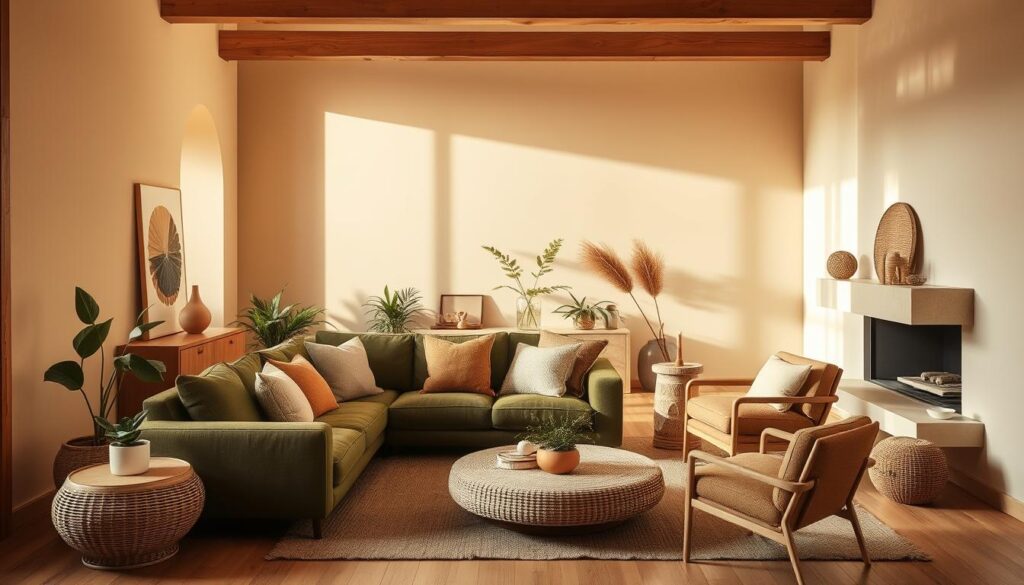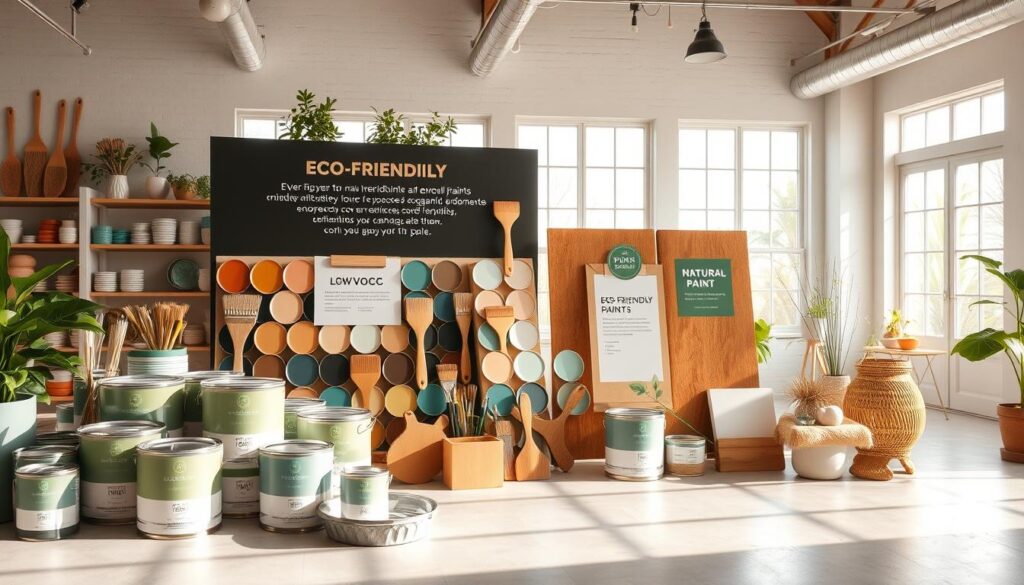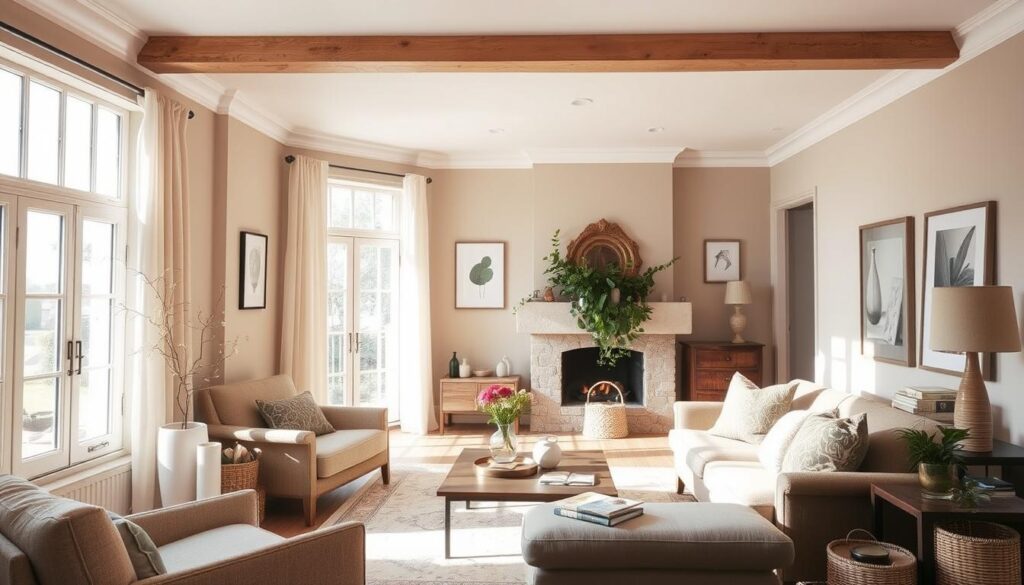Did you know that the colors you choose for your interior paint can affect your mood and well-being? The right color scheme can change your space, making it feel more welcoming and cozy.
At Ouma Atelier, we know how crucial it is to pick the perfect home interior color schemes to improve your living area. In this detailed guide, we’ll show you how to pick the best interior home colors that match your style and preferences.
Key Takeaways
- Understand the impact of color on your mood and well-being
- Learn how to choose the perfect color scheme for your space
- Discover the latest trends in interior paint colors
- Get practical tips for selecting the best colors for your home
- Transform your space with our expert guidance
Understanding the Importance of Color in Interior Design
In interior design, color plays a huge role. It affects our mood, behavior, and how we see a space. Color is a powerful tool that can change a room’s feel, making it either inviting or not. We’ll look into how color impacts us and our view of space.
The Psychological Effects of Color
Colors deeply affect our emotions and actions. For example, warm colors like red, orange, and yellow boost energy and warmth. On the other hand, cool colors like blue, green, and purple calm us down. Knowing these effects is key when picking popular home interior colors to set the right mood in your home.
The emotional impact of color goes beyond personal taste. It’s also shaped by culture and personal experiences. For instance, white means purity and cleanliness in the West but mourning in many Asian cultures. Knowing these differences helps you choose colors wisely for your home.
How Color Impacts Space Perception
Color also changes how we see a room’s size and layout. Lighter colors make rooms seem bigger and more open. Darker colors, on the other hand, make them feel cozy and close. This is vital when picking how to choose interior paint colors for any room size.
Also, color can highlight certain features or hide others. By understanding how colors work with space, you can make your home look better and more balanced.
Popular Interior Home Colors for 2023
As we enter 2023, the world of interior design is buzzing with new color trends. These trends promise to change our living spaces. This year, we see bold, vibrant colors and soothing, neutral tones. They appeal to many tastes and styles.
Trending Shades for Modern Spaces
The top color trends for 2023 aim for a balance between modern and cozy. Some popular shades include:
- Deep Blues: Rich, deep blues add sophistication and elegance to homes.
- Earth Tones: Shades like terracotta and sienna warm up living spaces.
- Soft Greens: Soft green hues create calming, natural environments.
Timeless Colors That Never Go Out of Style
Some colors stay popular over time. They are loved for their versatility and lasting appeal.
- Crisp Whites: White keeps homes looking clean and fresh.
- Soft Grays: Gray suits many design styles, from modern to traditional.
- Warm Beiges: Beige and other neutrals offer a soothing, inviting feel.
Using these colors in your home makes it stylish and comfortable.
Choosing the Right Color Palette for Your Home
Creating a beautiful color scheme for your home is all about understanding color selection. A well-chosen color palette can make your home feel welcoming and cohesive.
Choosing between complementary or contrasting colors is a big decision. Complementary colors, like blue and orange, are opposite each other on the color wheel. They make each other look brighter and more intense. Contrasting colors, on the other hand, are just different from each other. Mixing both can add depth and interest to your rooms.
Complementary vs. Contrasting Colors
Knowing the difference between complementary and contrasting colors is key to a harmonious scheme. “Color is a power which directly influences the soul,” said Wassily Kandinsky, a color theory expert. This shows how color affects our feelings in a space.
For a calming atmosphere, consider analogous colors (next to each other on the color wheel). But for a bold look, complementary colors work well.
Creating a Cohesive Look Across Rooms
Making different rooms look cohesive can be tough. But, there are ways to do it. Choose a unifying color that appears in each room, through paint, furniture, or decor. This creates a sense of continuity.
Another method is to pick a dominant color and use its variations in each room. For example, use different shades of blue in various rooms for a cohesive yet varied look.
For interior color palette inspiration, look to nature or art. Nature’s colors, like a sunset or a garden, are stunning. Art also offers beautiful color combinations.
The secret to a great color palette is balance. Balance warm and cool tones, and light and dark shades. This creates a visually appealing and harmonious interior that shows off your style.
Factors to Consider When Selecting Colors
Choosing colors for your home is complex. It’s not just about picking a color you like. It’s about creating a mood that fits the space’s purpose and design.
Lighting and Its Role in Color Choice
Lighting greatly affects how interior home colors look in your home. Natural light, artificial light, and room direction all play a part. A color might look great in bright light but different in dim light.
Think about your room’s lighting when choosing colors. Test colors in natural light at different times. For rooms with little natural light, choose brighter colors to make up for it.
Room Functionality and Color Compatibility
The room’s purpose should guide your color choice. Soft blues and greens are calming, perfect for bedrooms. Bright colors can energize spaces like gyms or playrooms.
Think about what happens in the room and how you want to feel there. This helps narrow down your color choices. Understanding color, lighting, and room function helps create a better home atmosphere.
Color Selection for Different Rooms
Choosing the right colors for each room is key to creating a great atmosphere. Different rooms have different uses, and their colors should match. We’ll look at the best colors for living rooms, bedrooms, kitchens, and dining areas.
Living Room and Common Areas
The living room is where you relax and entertain. Choose warm and inviting colors to make it cozy. Beige, soft grays, and taupe are popular home interior colors that welcome everyone.
For a modern vibe, bold accent walls or vibrant pieces can add excitement. But, too much boldness can overwhelm the space.
Bedrooms and Relaxation Spaces
Bedrooms are your retreat. They need colors that calm and soothe. Soft blues, pale greens, and muted purples are best interior paint colors for a peaceful feel.
Think about the room’s natural light when picking colors. Darker shades work well with lots of sunlight. Lighter colors brighten up dim rooms.
Kitchens and Dining Areas
Kitchens and dining areas are lively. Choose colors that energize and last. Warm colors like oranges, yellows, and reds are great for sparking conversations.
In kitchens, match your paint to your cabinets and countertops. A cohesive color scheme makes the space look better.
| Room Type | Recommended Colors | Effect |
|---|---|---|
| Living Room | Warm beiges, soft grays | Creates a welcoming atmosphere |
| Bedrooms | Soft blues, pale greens | Promotes relaxation and serenity |
| Kitchens/Dining | Oranges, yellows, reds | Stimulates appetite and conversation |
How to Use Color to Enhance Your Home’s Features
Color can change your home by focusing on its special parts. It can make your home look better and feel welcoming. This is true when color is used wisely.
Highlighting Architectural Elements
Colors can make crown molding, built-in shelves, and vaulted ceilings stand out. A different color for these features can catch your eye. For example, a bold ceiling color can make a room feel cozy, while a light shade can make it seem bigger.
Here are some tips to highlight architectural elements:
- Choose a color that goes well with your home’s colors but stands out.
- Think about the room’s lighting and how it changes the color’s look.
- Try a color sample before deciding on a shade.

Utilizing Accent Walls Effectively
Accent walls are great for adding color and interest. They can make a room’s features pop and create a focus. Pick a wall that naturally catches your eye, like the one behind a fireplace or a bed.
The accent wall color should match the room’s colors. Think about the color’s mood and how it will change the room’s feel. For instance, a warm red can make a room cozy, while a cool blue can relax you.
| Room Type | Suggested Accent Wall Color | Effect |
|---|---|---|
| Living Room | Warm Red or Orange | Creates a cozy and inviting atmosphere |
| Bedroom | Soft Blue or Green | Promotes relaxation and calmness |
| Kitchen | Bright Yellow or White | Adds energy and makes the space feel larger |
Using color wisely can make your home more beautiful and useful. Whether it’s highlighting architectural details or using accent walls, the right colors can greatly improve your home’s look and feel.
Practical Tips for Testing Interior Colors
Before you decide on a color for your interior, it’s smart to test it first. Testing colors helps you choose the right one. It makes sure the color fits well with your home’s look and your taste.
Sample Swatches and Painter’s Tape
Using sample swatches and painter’s tape is a great way to test colors. Paint small wall sections with different colors. This lets you see how they look without fully committing.
For example, try different shades of a color on various wall sections. This is helpful when picking complementary colors for your design.
Viewing Colors at Different Times of Day
It’s also important to see how colors look at different times. Natural light changes, affecting color perception. A color might look great in the morning but different at night.
- Look at the color in the morning with natural light.
- Check it again at night under artificial lighting.
- Think about how the color looks during different activities, like reading or watching TV.
Testing colors at different times ensures they look good all day. For more ideas, check out our article on top 10 interior home decor ideas for a stylish space.
By using these tips, you can pick the perfect colors for your home. This way, you’ll have a beautiful and harmonious space that shows off your style and fits the latest top interior design color trends.
Eco-Friendly and Sustainable Color Choices
We’re becoming more aware of the need for eco-friendly interior design. This includes choosing colors wisely. Now, we prefer sustainable and non-toxic paints for our homes.

Choosing the right paint colors is more than just looks. It’s also about making eco-friendly choices. We look for non-toxic paints that are safe for our families and the planet.
Choosing Non-Toxic Paints
Non-toxic paints don’t have harmful chemicals that can harm our air. Low-VOC (Volatile Organic Compound) paints are a good choice. They release fewer fumes, making them better for homes, even for those with allergies.
For inspiration on sustainable color palettes, check out nature-inspired color palettes. They bring the outdoors in and support eco-friendly living.
The Benefits of Low-VOC Options
Low-VOC paints improve our air quality and reduce harm to the environment. By picking low-VOC paints, we lower our carbon footprint and make our homes healthier.
- Improved indoor air quality
- Reduced environmental impact
- Healthier living spaces
As we focus on sustainability in home design, choosing eco-friendly paints is key. It helps us create a greener living space.
Final Thoughts on Choosing Interior Home Colors
Choosing the right interior home colors is all about reflecting your personal style. The colors you pick can make your space feel more welcoming and cozy.
Embracing Your Unique Taste
There’s no single color that fits everyone. Trends and advice are useful, but your personal taste should guide your choice. Look for interior paint colors that match your style and preferences.
Professional Guidance for Optimal Results
Not sure about the best colors for your home? Getting help from professionals can be a good idea. Interior designers and color consultants offer insights and recommendations that fit your needs. They help ensure your home looks exactly how you want it to.


